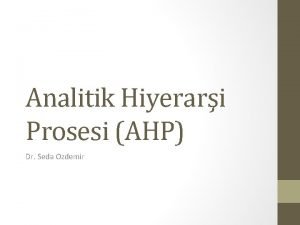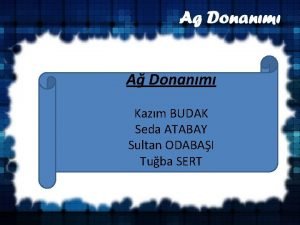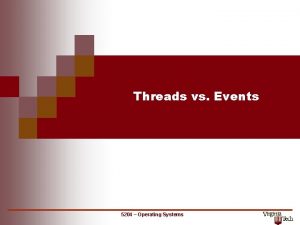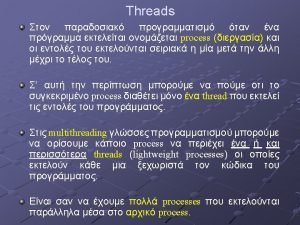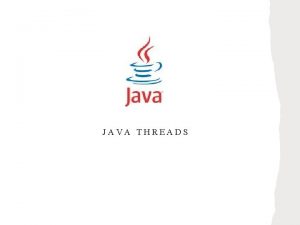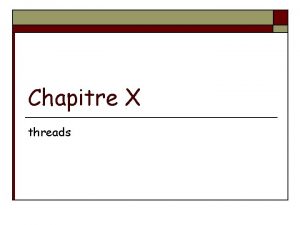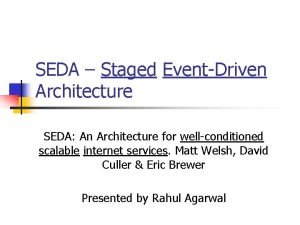Threads vs Events SEDA An Event Model 5204













- Slides: 13

Threads vs. Events SEDA – An Event Model 5204 – Operating Systems

Threads vs. Events Cappricio n Philosophy Thread model is useful ¨ Improve implementation to remove barriers to scalability ¨ n Techniques User-level threads ¨ Linked stack management ¨ Resource aware scheduling ¨ n Tools Compiler-analysis ¨ Run-time monitoring ¨ CS 5204 – Operating Systems 2

Threads vs. Events Capriccio – user level threads yield Capriccio kernel n n n User-level threading with fast context switch Cooperative scheduling (via yielding) Thread management costs independent of number of threads (except for sleep queue) n n Capriccio polling scheduler asynch I/O scheduler kernel Intercepts and converts blocking I/O into asynchronous I/O Does polling to determine I/O completion CS 5204 – Operating Systems 3

Threads vs. Events Compiler Analysis - Checkpoints n n Call graph – each node is a procedure annotated with maximum stack size needed to execute that procedure; each edge represents a call Maximum stack size for thread executing call graph cannot be determined statically ¨ ¨ n Insert checkpoints to allocate additional stack space (“chunk”) dynamically ¨ ¨ ¨ n Recursion (cycles in graph) Sub-optimal allocation (different paths may require substantially different stack sizes) On entry (e. g. , CO) On each back-edge (e. g. C 1) On each edge where the needed (maximum) stack space to reach a leaf node or the next checkpoints exceeds a given limit ( Max. Path) (e. g. , C 2 and C 3 if limit is 1 KB) Checkpoint code added by source-source translation CS 5204 – Operating Systems 4

Threads vs. Events Linked Stacks n main n ¨ ¨ A B Thread stack is collection of non-contiguous blocks (‘chunks”) Min. Chunk: smallest stack block allocated Stack blocks “linked” by saving stack pointer for “old” block in field of “new” block; frame pointer remains unchanged Two kinds of wasted memory n Two controlling parameters ¨ ¨ C n Internal (within a block) (yellow) External (in last block) (blue) Max. Path: tradeoff between amount of instrumentation and runtime overhead vs. internal memory waste Min. Chunk: tradeoff between internal memory waste and external memory waste Memory advantages ¨ ¨ Avoids pre-allocation of large stacks Improves paging behavior by (1) leveraging LIFO stack usage pattern to share chunks among threads and (2) placing multiple chunks on the same page CS 5204 – Operating Systems 5

Threads vs. Events Resource-aware scheduling n Blocking graph ¨ ¨ n Blocking graph formed dynamically ¨ n Edge – exponentially weighted average resource usage Node – weighted average of its edge values (average resource usage of next edge) Resources – CPU, memory, stack, sockets Resource-aware scheduling: ¨ ¨ n Appropriate for long-running program (e. g. web servers) Scheduling annotations ¨ ¨ ¨ n Nodes are points where the program blocks Arcs connect successive blocking points Dynamically prioritize nodes/threads based on whether the thread will increase or decrease its use of each resource When a resource is scarce, schedule threads that release that resource Limitations ¨ ¨ ¨ Difficult to determine the maximum capacity of a resource Application-managed resources cannot be seen Applications that do not yield CS 5204 – Operating Systems 6

Threads vs. Events Performance comparison n Apache – standard distribution Haboob – event-based web server Knot – simple, threaded specially developed web server CS 5204 – Operating Systems 7

Threads vs. Events SEDA – Staged Event-Driven Architecture n Goals ¨ Massive concurrency n n n ¨ Simplify constructing well-conditioned services n “well conditioned”: behaves like a simple pipeline offers graceful degradation, maintaining high throughput as load exceeds capacity provides modular architecture (defining and interconnecting “stages”) hides resource management details n ability to analyze and adapt to the request stream n thread pool sizing dynamic event scheduling n n n ¨ ¨ Introspection Self-tuning resource management n n required for heavily used web servers large spikes in load (100 x increase in demand) requires efficient, non-blocking I/O Hybrid model ¨ combines threads (within stages) and events (between stages) CS 5204 – Operating Systems 8

Threads vs. Events SEDA’s point of view Thread model and performance Event model and performance CS 5204 – Operating Systems 9

Threads vs. Events SEDA - structure n n Event queue – holds incoming requests Thread pool ¨ ¨ n Event handler ¨ ¨ ¨ n takes requests from event queue and invokes event handler Limited number of threads per stage Application defined Performs application processing and possibly generates events for other stages Does not manage thread pool or event queue Controller – performs scheduling and thread management CS 5204 – Operating Systems 10

Threads vs. Events Resource Controllers Thread pool controller n Thread added (up to a maximum) when event queue exceeds threshold n Thread deleted when idle for a given period Batching controller n Adjusts batching factor: the number of event processed at a time n High batching factor improves throughput n Low batching factor improves response time n Goal: find lowest batching factor that sustains high throughput CS 5204 – Operating Systems 11

Threads vs. Events Asynchronous Socket layer n n Implemented as a set of SEDA stages Each asynch. Socket stage has two event queues Thread in each stage serves each queue alternately based on time-out Similar use of stages for file I/O CS 5204 – Operating Systems 12

Threads vs. Events Performance n Apache ¨ n Flash ¨ ¨ n process-per-request design event-drived design one process handling most tasks Haboob ¨ SEDA-based design Fairness n n n Measure of number of requests completed per client Value of 1 indicates equal treatment of clients Value of k/N indicates k clients received equal treatment and n-k clients received no service CS 5204 – Operating Systems 13







